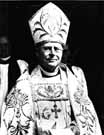
|
|
|

|

|

|

|
|
Click on an image to see a larger, more detailed picture.
|
|
|
|
|
| 1943: Death and Resistance |

|
pg. 440 |

|
|
|
|
| |
 The bima from the destroyed synagogue in Lvov, Ukraine, remained largely intact after the liquidation of the ghetto. The ghetto officially became a labor camp in January 1943, but 10,000 Jews without employment cards were executed. A "cleansing" operation in March murdered 1500 more Jews and transported another 800 to a Nazi death camp. Armed resistance during the final liquidation compelled the Germans to destroy the ghetto building by building. Lvov's Greek Catholic Church expressed unhappiness with these events--not so much over the destruction of the Jews (the Church was of the opinion that Jewry was dedicated to the destruction of Christianity)--but because Ukrainian locals were encouraged to participate in the murders.
The bima from the destroyed synagogue in Lvov, Ukraine, remained largely intact after the liquidation of the ghetto. The ghetto officially became a labor camp in January 1943, but 10,000 Jews without employment cards were executed. A "cleansing" operation in March murdered 1500 more Jews and transported another 800 to a Nazi death camp. Armed resistance during the final liquidation compelled the Germans to destroy the ghetto building by building. Lvov's Greek Catholic Church expressed unhappiness with these events--not so much over the destruction of the Jews (the Church was of the opinion that Jewry was dedicated to the destruction of Christianity)--but because Ukrainian locals were encouraged to participate in the murders.
Photo: Bildarchiv Preussischer Kulturbesitz / United States Holocaust Memorial Museum Photo Archive
|
 William Temple, religious head of the Church of England, was one of a handful of British voices speaking out on behalf of the Jews. In March 1943 he moved in the House of Lords that Britain lift all quotas on Jewish immigration into their country. He also advocated warning the Germans that those responsible for war crimes would be held accountable once the war was over.
William Temple, religious head of the Church of England, was one of a handful of British voices speaking out on behalf of the Jews. In March 1943 he moved in the House of Lords that Britain lift all quotas on Jewish immigration into their country. He also advocated warning the Germans that those responsible for war crimes would be held accountable once the war was over.
Photo: AP/Wide World
|
 This official-looking German document certified that Bronislawa Tymejko (Laura Schwarzwald) was employed by the agricultural cooperative in Busko-Zdroj. False papers such as this enabled Polish Jews to live under assumed names and avoid deportation. Although conditions within the work cooperatives run by the Nazis were harsh, the laborers were not worked to death. False papers, therefore, were virtually a staff of life for Jews fortunate enough to obtain them.
This official-looking German document certified that Bronislawa Tymejko (Laura Schwarzwald) was employed by the agricultural cooperative in Busko-Zdroj. False papers such as this enabled Polish Jews to live under assumed names and avoid deportation. Although conditions within the work cooperatives run by the Nazis were harsh, the laborers were not worked to death. False papers, therefore, were virtually a staff of life for Jews fortunate enough to obtain them.
Photo: Sophie Turner-Zaretsky / United States Holocaust Memorial Museum Photo Archive
|
|

|

|

|

|
 March 25, 1943: An anonymous letter written by a non-Jewish German citizen, critical of Nazi ghetto-liquidation techniques, is forwarded to Hitler's Chancellery.
March 25, 1943: An anonymous letter written by a non-Jewish German citizen, critical of Nazi ghetto-liquidation techniques, is forwarded to Hitler's Chancellery.
|
 Spring 1943: Nazi kill squads have so far murdered almost two million Jews in Eastern Europe.
Spring 1943: Nazi kill squads have so far murdered almost two million Jews in Eastern Europe.
|
 Spring 1943: The Germans force Jewish prisoners to burn the bodies of 600,000 Jews exterminated at Belzec.
Spring 1943: The Germans force Jewish prisoners to burn the bodies of 600,000 Jews exterminated at Belzec.
|
 April 1943: A concentration camp is established at Bergen-Belsen, Germany.
April 1943: A concentration camp is established at Bergen-Belsen, Germany.
|
 April 1943: Germans launch an offensive against Jewish partisans active in the Parczew Forest, Poland.
April 1943: Germans launch an offensive against Jewish partisans active in the Parczew Forest, Poland.
|
 April 1943: Resistance members derail a death train in Belgium.
April 1943: Resistance members derail a death train in Belgium.
|
|
|
|
|
| 1943: Death and Resistance |

|
pg. 440 |

|
|
The Holocaust Chronicle
© 2009 Publications International, Ltd.
|
|
